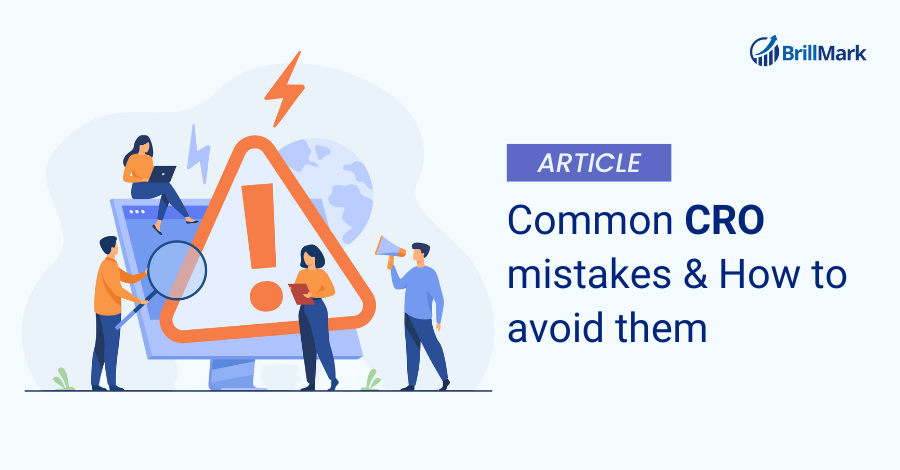Note: If you are aware of these potential obstacles, you will be able to run your activities more effectively and have time to address other less prevalent, organization-specific issues.
Just imagine. You’ve conducted a promising conversion test. You develop an A/B test to a page redesign to increase the amount of demo requests on your product pages.
Half of the page’s visitors view the old design, and half see the new one.
After a month of testing, conversions rise from 5% to 10%.
Cheers! do you feel amazing! You provide the data to your supervisor and recommend that all product pages should be migrated to your redesign based on your findings.
They give you the green light.
However, the subsequent number of demo requests decreases after implementing the new design. You speculate that it may be seasonal, so you wait a few more months.
But, boom! Your metrics are going in the opposite direction compared to your test results!
Despite your best attempts, this obstacle occurs to most.
Why?
Sometimes it happens at random. Sometimes it may reflect market changes. But, mainly, it’s something we did not consider or a statistical error.
At Brillmark, we acknowledge that as CRO practitioners and marketers, conversions are the holy grail for you.
Having worked with hundreds of businesses over the past decade, we know that the path to conversion rates you can be proud of is not linear.
We have assisted hundreds of optimizers across businesses and locations. With this experience, we have identified common patterns in their errors.
This article discusses the top errors that CRO practitioners should avoid and why having assistance from conversion rate optimization experts like Brillmark can help you avoid these mistakes.
Did you know?
According to Optimizely, “Using A/B testing, President Obama raised an additional $60 million.”
What is Conversion Rate Optimization (CRO)?
Conversion rate optimization is a scientific method for boosting the proportion of site users who become customers.
It employs gathered data, analytics, and ideas to build a hypothesis on how to increase conversions.
Next, A/B testing tools are utilized to validate your hypothesis and attain your objectives.
Due to its influence on the bottom line, conversion rate optimization (CRO) is crucial in today’s market.
A good conversion rate optimization campaign will result in considerable time, money, and effort savings and enable you to explore previously untested growth strategies.
CRO can be challenging, but its ultimate objective is to enhance conversion rates.
Common CRO mistakes & how to avoid them
Testing without a strategy
In our experience, poor scheduling causes the failure of many CRO initiatives. For instance, testing conducted around the holidays will likely give misleading findings for your SaaS firm since your target audience is likely on vacation.
Poor scheduling may decrease web page performance rather than improve it.
During the course of a preliminary study, it is vital to establish phases for your experiments, such as generating tests, doing quality assurance, releasing the test, and awaiting findings.
A strategy or CRO roadmap helps you monitor the schedules and development of your trial at each stage, ensuring accurate findings.
For a pleasant voyage, it is strongly advised to design a plan for at least one quarter.
Putting instant gains ahead of the process.
CRO is not a straightforward procedure. This is because experimenting is key to this iterative and data-driven strategy.
In other words, conversion rate optimization is the continual practice of monitoring the performance of your website’s content and experimenting with ways to enhance the overall user experience.
Ultimately, CRO will tell you and your team what works for your online audience and how to maximize your present internet traffic if done correctly.
The early stages of CRO may feel quite monotonous.
This is because CRO tests should only test a single element of a page to ascertain with precision whether or not a particular modification influenced user behavior favorably or adversely.
Not conducting experiments on pages or campaigns that are currently successful.
It is not simply because something performs well that you should leave it alone. Frequently, these marketing assets have the most significant potential to perform even better after being optimized.
“Performing well” is not the same as “optimized” – and you won’t know how much potential for improvement there is until you experiment. Plus, a higher baseline conversion rate means a stronger signal and faster experiment results. There’s no reason not to try.
Brian David Hall
Conversion Optimizer and Analytics Strategist
Some of our most significant CRO victories for our customers have sprung from assets already working effectively.
Avoid becoming preoccupied with optimizing marketing assets that require the most significant improvement.
Frequently, the lowest-hanging fruit consists of sites currently doing well in traffic and/or leads and, when improved further, can result in considerably more significant gains.
Did you know?
According to Convert & VWO, just one out of every seven A/B testing yields statistically meaningful results. However, the same numbers also revealed that agency-run examinations have a higher success rate of 33.3%.
Misinterpreting outcome report
Studying and comprehending test findings might be difficult for someone new to CRO. A perfect test report contains at least three objectives that must be carefully checked.
People have a tendency to become ecstatic if they observe an increase in one of their objectives while neglecting other objectives and metrics that may be affecting their experiments holistically.
This may cause them to prematurely terminate the test before it achieves statistical significance or make judgments based on inconclusive findings.
Consultation with the platform’s team or representative is the optimal method for understanding the results of a few tests.
Here are some inquiries you may ask when attempting to comprehend the mechanics of the platform you are utilizing:
- How do we determine statistical significance?
- What is the report’s winner?
- What is an intelligent choice in the report?
- How should the report be interpreted?
Not monitoring minor conversions
As a CRO practitioner, your company KPIs may involve tracking large macro conversions like revenue, free trial signups, demo/quote requests, purchases, bookings, and checkouts, among others.
But do you measure micro conversions—the incremental steps that lead to the ultimate objective?
Let’s expand our comprehension of micro conversions.
Micro conversions, such as form submissions, element visibility, scroll depth, CTA clicks, etc., are crucial in influencing your website’s performance and user experience.
These actions allow you to evaluate client behavior throughout their online experience.
Approaching all traffic equally
To build a compelling marketing message, you must understand your clients.
Differentiating between different forms of traffic enables you to create customer segments, which may help you differentiate and identify trends in the types of individuals you should be targeting explicitly – your ideal customer.
With a clear understanding of who your target audience is and who it is not, you can create customized, one-of-a-kind online experiences and hone in on what converts your perfect client.
For instance, ensuring that your website is equally suitable for mobile and desktop consumers.
If your website is quick to load, simple to navigate, gives a clear message, and has an attractive offer, you have a conversion.
Remember that none of this is feasible without actual data from testing, monitoring the appropriate key metrics, considering timing, and knowing which variants to apply and scale.
Decide to abandon a “loser” experiment
A “loser” experiment is one in which the variant you generated had a negative impact on conversions or did not outperform the control.
In contrast, the idea of “loser” does not exist in CRO; all tests are in some sense successful.
Every test you conduct on your website might provide vital insights. Each test brings you closer and closer to a complete comprehension of your audience.
Do not surrender on your test! If you have a variation with a negative uplift, consider answering the following questions:
- Why was the standard superior to the variant?
- What can the results educate me about my target demographic?
- Are there any favorable outcomes based on the experiment’s monitored conversions?
- Based on these data, what hypotheses can I form?
Depending only on A/B testing as your CRO strategy.
A/B testing will be the first of many conversion rate optimization techniques you will test.
A/B testing, also known as split testing, involves creating and comparing two versions of a website or landing page to discover which one performs better.
The page with the highest conversion rate will be implemented.
Based on statistical analysis, a company can test numerous adjustments, such as a single headline or button, from fundamental color changes to a call-to-action or a whole page redesign to determine which variant has a greater conversion rate.
Unfortunately, putting most of your CRO on A/B testing alone is a one-trick pony that might be costly.
It might be challenging to conduct tests on pages with little traffic due to the time required to collect enough essential data.
Conversions may decline if decisions are made without sufficient evidence or poor conversion rates.
In these scenarios, a firm can take three actions:
- Rather than limiting yourself to a single variable, split-test two contrasting alternatives, such as style and layout, headlines, and other elements.
- Perform numerous exams more regularly to get more information
- Tests must be conducted for longer durations to provide meaningful findings (traffic fluctuates at different times of the day, week, month, and holiday periods, etc.)
How Optimization Tools for Conversion Rates Can Help
As the digital environment expanded in the twenty-first century, website marketers began looking for methods to improve the user experience and increase revenue.
This activity led to developing new conversion rate optimization tools like Google Analytics, Google Optimize, Survey Monkey, Hotjar, Crazy Egg, etc., which made CRO testing and analysis possible.
Marketers started experimenting with website design, content, images, and other factors to increase their conversion rates.
Did you know?
According to Wordstream, the average ROI for CRO tools is 223%.
Imagine if the website concentrating on that specific product page was able to boost its conversion rate for that page from 15% to 20% utilizing CRO technologies.
This would result in a 50% increase in conversions, which would significantly impact the bottom line.
Imagine what would happen if an agency specializing in conversion rate optimization assisted the firm in analyzing the remainder of its product pages.
The potential increase in total conversions will be tremendous.
Build your CRO campaign with Brillmark
If you know how to use tools such as Google Analytics, you should be able to independently develop a sound CRO hypothesis.
However, conducting efficient A/B tests is complex, and organizations frequently require the assistance of CRO testing specialists like BrillMark.
Additionally, we concentrate on Ecommerce conversion rate optimization.
We assist businesses in moving their hypotheses and objectives into the testing phase. BrillMark can construct and run complicated tests across any device, application, or platform with reliability.
With over 10,000 tests under our belt, we can determine if your hypothesis is valid, if it requires modification, or if you need to run further variants.
Beyond what the testing tools give, our specialists can also create bespoke audiences to further segment your audience and compare their distinct behaviors.
BrillMark will assist you in interpreting the test results created by the testing tool, which include the quantifiable elements influencing the conversion rates of both the original pages and the variants we generate.
If the translation is proved to increase conversion rate and income, we will assist you in implementing it on your whole website.
Want to learn more about how BrillMark CRO testing may assist your business in generating more leads and revenue?
Let’s discuss testing. Reserve a 30-minute consultation slot on our calendar.
Conclusion
We hope this list has motivated you to enhance your CRO abilities and adopt a more methodical approach to your tests.
Mastering conversion rate optimization is a high learning curve, and there are no shortcuts. You may save substantial time (and money) by avoiding the errors mentioned above.
Failure in CRO does not mean you should quit. Every step is a learning experience. Take a pragmatic approach to each experiment you conduct and consider the significant errors discussed in this piece.
There are many methods to reach the target conversion rates and no secret ingredient.
However, the actual value of CRO resides in a persistent and rigorous commitment to learn, adapt, and improve every day at your game. So, stay curious and continue exploring.
Brillmark is here to assist you in avoiding common CRO mistakes and much more. This assistance exceeds the scope of this blog.
Contact us now to get in touch with us.











